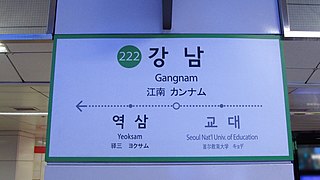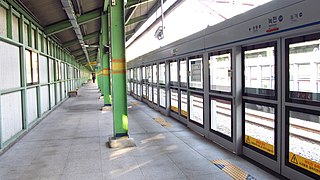
Incheon, formerly Jemulpo or Chemulp'o (제물포) until the period after 1910, officially the Incheon Metropolitan City, is a city located in northwestern South Korea, bordering Seoul and Gyeonggi to the east. Inhabited since the Neolithic, Incheon was home to just 4,700 people when it became an international port in 1883. Today, about 3 million people live in the city, making it South Korea's third-most-populous city after Seoul and Busan.

Yongsan Station is a major railway station in the Yongsan District of Seoul, South Korea. The station adjoins the Yongsan Electronics Market. The station is the terminus for high-speed and long-distance trains on a number of railway lines, including most trains on the Honam Line, its high-speed counterpart, and all trains on the Janghang and Jeolla Lines.

Seoul Subway Line 2, also known as the Circle Line, is a circular line of the Seoul Metropolitan Subway. The line running clockwise is called the "inner circle line" and the counter-clockwise line is called the "outer circle line". This is Seoul's most heavily used line, and consists of the main loop, the Seongsu Branch and the Sinjeong Branch for a total line length of 60.2 km (37.4 mi). The Line 2 loop is the third longest subway loop in the world after Moscow Metro Bolshaya Koltsevaya line and Beijing Subway Line 10. In 2019, Line 2 had an annual ridership of 812 million passengers or 2.2 million passengers per day.

Seoul Subway Line 9, operated by Seoul Line9 Operation, is a subway line in Seoul, part of the Seoul Metropolitan Subway. The line runs east from Gaehwa station or Gimpo International Airport station along the south bank of the Han River towards VHS Medical Center in Gangdong. In 2019, Line 9 had an annual ridership of 225 million or about 616,000 people per day.

Gangnam is a station on Line 2 of the Seoul Metropolitan Subway. The station is located within the Greater Gangnam Area between the Gangnam and Seocho Districts of Seoul, South Korea. The station is the busiest station on the Seoul Metropolitan Subway, serving over 70,000 daily passengers on average.

Dangsan Station (Korean: 당산역) is an elevated station on the Seoul Subway Line 2 and is an underground station on the Seoul Subway Line 9. The station is located on the south bank of the Han River in Yeongdeungpo District. Because the station is elevated, trains exiting to or entering from the north make use of the Dangsan Railway Bridge. As of April 2009, the platform has been outfitted with platform screen doors. Dangsan station is currently a transfer point between Line 2 and Seoul Subway Line 9. Several Korean TV series were shot in nearby locations, like Boys Over Flowers, Iris or My Girlfriend is a Gumiho.

Sinsa station is a station on the Seoul Subway Line 3 and the Shinbundang Line. It is located in Sinsa-dong, Gangnam-gu and Jamwon-dong, Seocho-gu, Seoul. It will serve as the northern terminus of the Wirye–Sinsa Line when it is opened in 2025.

Nambu Bus Terminal Station is a subway station on the Seoul Subway Line 3 in Seocho-gu, Seoul. Its substation name is Seoul Arts Center. As its name indicates, it serves the nearby Nambu Bus Terminal. It is also the closest station to the Seoul Arts Center, located about a half-mile southwest of here. When this line opened, this station was called the Cargo Truck Terminal.

Cheongnyangni Station (Korean: 청량리역) is a major railway station located at Dongdaemun District, Seoul, South Korea. It serves as a terminus for passenger trains serving the eastern part of South Korea. KTX, ITX-Cheongchun, and Mugunghwa-ho trains terminates or stops at this station. Several Seoul Metropolitan Subway lines serve the station. These are: Seoul Subway Line 1, the Gyeongchun Line, the Suin–Bundang Line and the Gyeongui–Jungang Line.

Geumjeong Station is a ground-level metro station on lines 1 and 4 of the Seoul Subway network in South Korea. The station is in Gunpo, a city approximately 15 km (9.3 mi) south of Seoul in Gyeonggi Province, between the cities of Anyang and Suwon. The name means that the land is covered with waves everywhere and that the water wets women's clothes.

Jamsil Station is an underground station on Line 2 and Line 8 of the Seoul Metropolitan Subway. Lotte World is continuous with the Line 2 station. The station is also called Songpa-gu Office Station (송파구청역), due to the proximity of the office building.

Noryangjin Station (Korean: 노량진역) is a metro station in southwest region of Seoul, South Korea. The station is located in the Noryangjin-dong (neighborhood) of Dongjak-gu (ward) and is also a stop on Seoul Subway Line 1 and Seoul Subway Line 9. This stop is a popular destination for those seeking to eat raw fish, and other assorted seafood, as a large, covered sea food market is located next to the station, accessible by foot bridge. The Line 1 station is also notable in that Exit 1 and 2 have the same number as Exit 1 and 2 of Line 9's station.

Doksan Station is a station on Line 1 of the Seoul Subway. It is an above-ground station located in southwestern Seoul, with service between Uijeongbu and Suwon/Cheonan.

Nokcheon station (Korean: 녹천역) is a metro station on Seoul Subway Line 1 in South Korea. It is located in the northern end of the city.

Bosan Station is a subway station located at Dongducheon, Gyeonggi-do, South Korea. This station is on the Seoul Subway Line 1. Camp Casey, an American military base, is located nearby.

Jichuk Station is a railway station located just northwest of Seoul on Seoul Subway Line 3. It is within walking distance to Eunpyeong-gu, Seoul. Jichuk station has a subway depot for Line 3 trains nearby.

Kwangwoon University station is a train station on Seoul Subway Line 1, Gyeongchun Line and Gyeongwon Line in Seoul, South Korea operated by Korail. Together with Incheon station and Suwon station, this station was one of the three termini of Line 1 when it opened in 1974. Seongbuk Depot, one of the five depots of Line 1, is located nearby.

Yangju Station is a train station on Seoul Subway Line 1 and the Gyeongwon Line. The name comes from Yangju, the city where this station is located. Until December 2007, it was called Junae Station.

Seojeongni Station is a station in Seojeong-dong, Pyeongtaek, South Korea. Mugunghwa-ho trains running on the Gyeongbu Line stop here. Additionally, services on Seoul Subway Line 1 have been calling at this station since 2005. Its station subname is Kookje College.

Gubeundari Station is a subway station on Seoul Subway Line 5 in Gangdong District, Seoul.






















